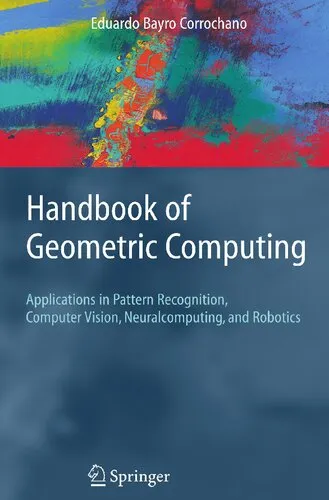Handbook of Geometric Computing: Applications in Pattern Recognition, Computer Vision, Neuralcomputing, and Robotics
4.0
Reviews from our users

You Can Ask your questions from this book's AI after Login
Each download or ask from book AI costs 2 points. To earn more free points, please visit the Points Guide Page and complete some valuable actions.Introduction to the Handbook of Geometric Computing
The Handbook of Geometric Computing: Applications in Pattern Recognition, Computer Vision, Neuralcomputing, and Robotics is an in-depth exploration of the transformative role that geometric computing plays in shaping advanced technical domains. Authored with precision and clarity, this book merges mathematical insights with practical implementations, making it an essential resource for researchers, students, and professionals interested in cutting-edge computational methodologies.
This handbook serves as a bridge between abstract concepts in mathematics and their real-world applications, effectively showcasing the relevance of geometric principles in solving complex engineering and computational challenges. By integrating key insights from pattern recognition, computer vision, neural computing, and robotics, the text provides a comprehensive framework for understanding the synergy between geometry and technology.
Detailed Summary of the Book
The core of this book lies in its structured approach toward geometric computing, a critical toolkit for modern technological advancements. Divided into carefully curated sections, the handbook begins by introducing fundamental mathematical concepts such as metric spaces, Euclidean geometry, and transformations. Readers are then guided through the application of these principles in solving real-world problems.
One of the key highlights is the focus on pattern recognition and computer vision. These sections delve into algorithms and strategies for recognizing patterns, from basic shapes to complex structures, enabling applications in industries ranging from healthcare to security systems. The book also dives into neural computing, demonstrating how geometric principles enhance deep learning algorithms, improve feature extraction, and optimize training processes.
A significant portion of the text is devoted to robotics. By presenting case studies and algorithms, the book illustrates how geometric computing enables autonomous machines to navigate and interact with their environments. You'll explore everything from robotic kinematics to path planning, all underpinned by robust geometric frameworks. This structure makes the book a powerful resource for individuals who aim to contribute to advancements in AI, robotics, and other interdisciplinary fields.
Key Takeaways
- A thorough understanding of geometric principles and their applications in computation.
- Insight into how geometric computing enhances pattern recognition systems, from basic image processing to complex object detection.
- Detailed knowledge of applying geometric frameworks in robotics for real-world innovations, including navigation and manipulation.
- Practical examples demonstrating how geometry is seamlessly integrated into neural network architectures.
- Strategies for leveraging the synergy between mathematics, computing, and engineering to solve innovative problems.
Famous Quotes from the Book
"Geometry is not only a pure science; it is the language of our technological evolution. By understanding space and form, we translate abstract ideas into machines that see, think, and move."
"In robotics and vision, equations are not merely calculations—they are the essence of interaction between man and machine."
Why This Book Matters
The role of geometric computing in revolutionizing technology cannot be overstated, and this book demonstrates that perfectly. From autonomous vehicles to artificial intelligence and beyond, geometry is at the core of modern systems that transform how we live and work.
By presenting a unified framework that connects geometric theory to practical applications, this book empowers readers to understand, innovate, and solve problems in ways previously unimaginable. Whether used as a reference for academic study or as a practical guide for industry applications, this handbook is a pivotal resource that encourages cross-disciplinary thinking, inspires technological breakthroughs, and bridges the gap between theory and practice.
Moreover, the book stands as an invitation to learn how geometry serves as the foundation for smarter, more efficient computational systems. With accessible explanations, illustrative examples, and an emphasis on real-world applications, it equips learners and professionals alike to push the boundaries of what's achievable in robotics, AI, and beyond.
Free Direct Download
You Can Download this book after Login
Accessing books through legal platforms and public libraries not only supports the rights of authors and publishers but also contributes to the sustainability of reading culture. Before downloading, please take a moment to consider these options.
Find this book on other platforms:
WorldCat helps you find books in libraries worldwide.
See ratings, reviews, and discussions on Goodreads.
Find and buy rare or used books on AbeBooks.
1190
بازدید4.0
امتیاز50
نظر98%
رضایتReviews:
4.0
Based on 0 users review
"کیفیت چاپ عالی بود، خیلی راضیام"
Questions & Answers
Ask questions about this book or help others by answering
No questions yet. Be the first to ask!


